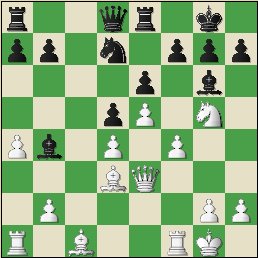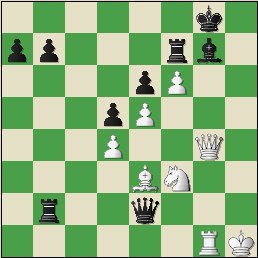G2: Topalov,V (2813) - Kramnik,V (2743) [D19]
WCh Elista RUS (2), 24.09.2006
[IM Malcolm Pein]
(Thanks to Mark Crowther,
The Week In Chess, and Malcolm Pein for commentary and analysis)
1.d4 d5 2.c4 c6 3.Nc3 Nf6 4.Nf3 dxc4 5.a4 Bf5 6.e3 [ 6.Ne5 e6 7.f3 Bb4 8.e4 Bxe4 was formerly ventured by Kramnik with White but Black's resources are thought to be more than adequate] 6...e6 7.Bxc4 Bb4 8.0-0 Nbd7 9.Qe2 Bg6 10.e4 0-0 [ 10...Bxc3 11.bxc3 Nxe4 12.Ba3 Forces Black to castle queenside into the teeth of an attack] 11.Bd3 Bh5 12.e5 Nd5 13.Nxd5 cxd5 14.Qe3 Bg6 15.Ng5 Re8 16.f4 Diagram
16...Bxd3 TN
[ 16...Rc8 17.g4! f6 18.Bxg6
( 18.f5!?) 18...hxg6 19.Nf3+/= Pelletier-Deviatkin Moscow 2003 TWIC 433; 16...Nf8 17.g4]
17.Qxd3 f5 trying to close the kingside
18.Be3 [ 18.g4!? h6! 19.Nxe6 Rxe6 20.gxf5 Re7-/+]
18...Nf8 Kramnik sets up a solid defence, the plans are clear, White goes for g2-g4 and a kingside attack Black seeks chances on the c file and if possible a queen exchange
19.Kh1 Rc8 20.g4! Qd7 [ 20...h6 21.Nxe6 Rxe6 22.gxf5 Rec6 23.Rg1 Kh8 24.Rg2 Nh7 25.Rag1 Bf8 26.Rg6! with dangerous threats like f5-f6; 20...fxg4 21.f5! Be7 22.Nxe6
( 22.f6 gxf6 23.exf6 Bxf6 24.Nf7!?) 22...Nxe6 23.fxe6]
21.Rg1 Be7 22.Nf3 Rc4 23.Rg2! Typical Topalov, us ordinary mortals would play b3 first and avoid having to give up a pawn
23...fxg4 24.Rxg4 Rxa4 25.Rag1 g6 [ 25...Ng6? 26.h4 Bf8 27.Ng5 h6 28.h5! Black's problem is that he would like to put both his minor pieces on f8]
26.h4 Rb4 [ 26...Bd8 27.h5 Re7 28.Nh4 Rg7 29.f5! Bxh4 30.f6 wins]
27.h5 Qb5 At this stage most people who were analysing with their computers and not their brains thought Kramnik was clearly better but Topalov clearly had an idea, and it is soon revealed
28.Qc2! Rxb2 Rb3 is answered similarly
29.hxg6!! h5 [ 29...Rxc2 30.gxh7+ Kxh7 31.Rg7+ Kh6 32.f5+ Kh5 33.R7g3!! Ng6 34.Rxg6 Rh8 35.f6!! mates]
30.g7! hxg4 [ 30...Nh7 31.Qg6 hxg4 32.Qxe6+ Kxg7 33.Qxg4+ wins]
31.gxf8Q+ Bxf8?? Diagram
[ 31...Kxf8 32.Qh7 Qe2 33.Qh8+ Kf7 34.Qh5+ Kf8 35.Qxg4 and now the missable 35...Bg5! keeps the game going 36.Re1!
( 36.fxg5? Qxe3) 36...Qc2 37.fxg5
( 37.Qxg5 Re7) 37...Ke7! heading for the hills and preparing Rh8+ this looks quite unclear]
32.Qg6+?? An incredible occurrence of mutual chess blindness, I wonder what Kasparov must have thought of this
[ 32.Rxg4+ Wins trivially after 32...Bg7
( 32...Kf7 33.Qg6+; 32...Kh8 33.Rh4+ Kg8 34.Qh7#) 33.Qc7 Qf1+ 34.Ng1!+- covers all the checks]
32...Bg7 33.f5! [ 33.Ng5 Re7]
33...Re7 [ 33...exf5 34.Bh6 Qd7 35.Ng5 with a ferocious attack for example 35...Rb6 36.e6 Rexe6 37.Qh7+ Kf8 38.Qh8+ Ke7 39.Qxg7+ Kd8 40.Nf7+ Kc8 41.Rc1+ Kb8 42.Bf4+ Ka8 43.Nd6 Qxg7? 44.Rc8#]
34.f6 Qe2 35.Qxg4 Rf7 Diagram
[ 35...Qxe3 36.fxe7 Qh6+ 37.Nh4 Kf7 38.Qxg7+ wins]
36.Rc1? Missing another win
[ 36.Qh5! Calmly intending Bh6 or Rg3 followed by fxg7 36...Qxe3
( 36...Rb3 37.Rxg7+ Rxg7 38.fxg7 Rb1+ 39.Bg1) 37.Ng5 Rc7 38.Qh7+ Kf8 39.Nxe6+ Kf7 40.Qxg7+ Kxe6 41.Qg4+ Kf7 42.Qg8#]
36...Rc2! 37.Rxc2 [ 37.Re1!? Qd3 38.Qh5]
37...Qd1+ In view of the coming endgame perhaps Qxc2 here was better
38.Kg2 Qxc2+ 39.Kg3 Diagram
Amazing, all three results were still possible
39...Qe4 Kramnik will always feel safer with queens off against Topalov, of course in this position its imperative
40.Bf4?! [ 40.Qxe4! dxe4 41.Ng5 Would have produced a most obscure endgame. Giving up material for the pawns seems to lose in all lines so 41...Bf8 and most likely 41...Rd7 are the best chances with the latter possibly surviving 41...Bf8
a) 41...Bxf6 42.Nxf7 Kxf7 43.exf6 a5 44.Kf4 a4
(a) 44...Kxf6 45.Bd2 a4 46.Bb4 e3 47.Kxe3 Kf5) 45.Bc1 wins;
b) 41...Rxf6 42.exf6 Bxf6 43.Nxe6 wins;
c) 41...Bh6 42.Nxf7 Bxe3 43.Nd8 is strong because 43...Bxd4 44.f7+ Kf8 45.Nxe6+ Kxf7 46.Nxd4 wins after 46...a5 47.Kf4 a4 48.Nb5 Ke7 49.Kxe4 So we have to examine 41...Bf8;
d) 41...Bf8 42.Nxe6 a5 43.Ng5 Rc7 44.e6 a4 45.d5 a3 46.Bd4 Bd6+ 47.Kg4 calmly crashing through, a rather instructive illustration of the power of passed pawns;
e) 41...Rd7 42.fxg7
(e) 42.Nxe6 Bxf6 43.exf6) 42...Rxg7 43.Kf4 Rg6 44.Kxe4 a5
(e) 44...b5!? Avoiding the fork on the long diagonal after promotion
45.d5 exd5+ 46.Kxd5 b4 47.e6 b3 48.e7 Rxg5+ 49.Bxg5=) 45.d5 exd5+ 46.Kxd5 a4 47.e6 a3 48.e7 Rxg5+ 49.Bxg5 Kf7 50.Kd6 a2 51.Bf6 Kxf6 52.e8Q a1Q 53.Qh8+; 42.Nxe6 a5 43.Ng5 My instincts were that Black should be doing well but Fritz uncorked 43...a4 44.Nxf7 a3 45.e6!! a2 46.Nh6+ Bxh6 47.Bxh6 a1Q 48.f7+ Kh7 49.f8Q]
40...Qf5 Get those queens off but 40...a5!? deserved attention
41.Qxf5 exf5 42.Bg5 [ 42.fxg7 Rxg7+ 43.Kf2 a5 And White is clearly struggling]
42...a5 43.Kf4 a4 44.Kxf5 a3 45.Bc1 Bf8 [ 45...a2 46.Bb2 Rc7 47.e6 Bf8 48.Ng5! Rc2? 49.e7]
46.e6 Rc7 47.Bxa3! The struggle intensifies yet again Topalov secures three connected passed pawns but Kramnik should win
[ Not 47.e7 Bxe7 48.fxe7 Rxe7 49.Bxa3 Re3-+]
47...Bxa3 48.Ke5 Rc1 49.Ng5 Rf1 [ 49...Rg1 forces the knight to an inferior square 50.Nf7 b5 51.Kxd5 Rf1 52.Ke5 b4 wins]
50.e7 Re1+ 51.Kxd5 Bxe7 52.fxe7 Rxe7 The six piece computer tablebases tell us this is a win but in practice with White's king near Black's only pawn there are drawing chances
53.Kd6 Re1 53...Re3 is the computer win
54.d5 Kf8 55.Ne6+ [ 55.Kd7 keeping the Black king away draws according to the computer 55...b5 56.Ne6+ Kf7 57.Nd8+ Kf6 58.Nc6 Rb1 59.Kd6! b4 60.Kc5 b3 61.Kc4 b2 62.Kc3]
55...Ke8 56.Nc7+ Kd8 57.Ne6+ Kc8 58.Ke7 Rh1 59.Ng5 [ 59.Kd6]
59...b5 60.d6 Rd1 61.Ne6 b4 62.Nc5 Re1+ 63.Kf6 Re3 2-0 to Kramnik, these games are starting to remind me of Tal and Botvinnik albeit rather obliquely.
0-1




Comments